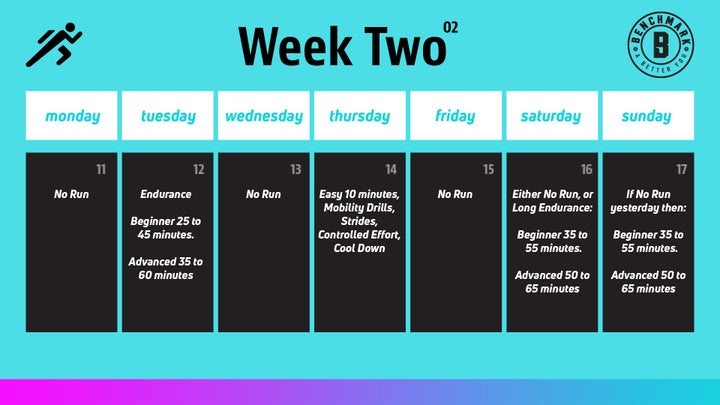New perk! Get after it with local recommendations just for you. Discover nearby events, routes out your door, and hidden gems when you sign up for the Local Running Drop.
Welcome to the second week of Triathlete’s Benchmark A Better You run month! By now you should have already done either your benchmark 5K or test set last weekend and last week’s workouts, but if you’re a little late to the party, you can still do your benchmark and simply shift the workouts’ start date accordingly. You don’t want to miss out on this opportunity to jumpstart your running this year with handwritten workouts from one of the sport’s top run coaches, Bobby McGee!
Each Monday we’ll post the run workouts for the week with a brief explanation and tips on how to properly complete each session. While you shouldn’t run more than suggested, feel free to sprinkle in swims, bike sessions, cross training, and core/strength workouts where your schedule (and energy levels) allow.
Also, each week will have two “flavors”: beginner and advanced. You should consider yourself a beginner if you come from a non-running background, are returning to running after a long time off, are recovering from an injury, or are looking to increase your running volume very slowly. Those who choose the advanced options should have a moderate-to-high running background, been running through the winter, or those who are confident in their running ability. To be clear, “beginner” does not mean slow, and “advanced” does not mean fast—a triathlete who is a lifelong runner with little-to-no history of injury should follow the advanced program, even if he or she averages 12 minutes/mile in a 5K.
This week’s workouts build off of last week’s slow roll back into running with an increase in distance and the first controlled efforts. Remember, even if you’re feeling great, keep it that way! There’s still no need to push yourself with more distance or speed than you’re ready for as you still get back into the swing of things. Patience now will pay off dividends later.
Benchmark a Better You: Run Workout Week #2
Note: Session notes are located after the weekly table.

Coach McGee’s notes for the week:
Week-Specific Notes:
Jan. 14 session: Warm up with a short walk, then 5 to 10 minutes of easy running. Complete some dynamic mobility drills if you know and use these. Complete 4 strides and then run at best controlled effort—like your benchmark run in the first week—of 7 to 10 one-minute efforts, with a 1-minute walk between each. Cool down with a 2-minute walk and a relaxed 5- to 7-minute run.
Jan. 16-17 session: Long Endurance can be on either Saturday or Sunday. The other day would be a no run day.
Overall Plan Notes:
- Athletes running only 3 times per week may choose to supplement their run training with walks. These are suggested in some form each week.
- Remember to take at least one day of a good recovery, but if you do two-a-days with swim and bike, these are best either completed back to back, (i.e., as one session) or with at least 5 hours apart.
Endurance Workout Notes:
- Walk 3 to 5 minutes before and after every endurance workout
- Choose the duration that best suits your current ability – doing more than you are currently doing will be unnecessarily risky and little stands to be gained
- It is highly recommended that individuals that have done no to little running, or are larger athletes, or have a slower gait consider the walk/run/walk method. Choose from a 4-minute run, 1-minute walk pattern, all the way up to a 9-minute walk/1-minute run pattern. The longer the run, the shorter the pattern. Complete beginners would do well to even consider 1, 2 or 3 minutes of running, with a 1-minute walk between.
- When choosing the run/walk/run approach, cover the duration suggested in the workout by running; the walks are extra. For example, if you choose to run for 30 minutes using a 4/1 pattern, then you will run 7 x 4-minute efforts and 1 x 2-minute run effort with 7 minutes of total walking in addition to your 30 total minutes of running.
- Advanced runners can consider the 6 to 9-minute run with a 1-minute (or less) walk for runs of durations at or above an hour. This will allow for greater progression and more rapid recovery with no loss of endurance benefits.
Stride Notes:
- Strides are essential neuromuscular conditioners that transfer your cardio-vascular endurance into faster running.
- Strides are pick-ups or acceleration runs that start gradually and build to a safe speed just beyond the fastest speed that you run for intervals or repetitions.
- If you know, or usually complete some dynamic mobility drills, these can be completed before strides AND quality workouts.
- Strides are of very brief duration. Keep them under 9 seconds. I suggest counting either left or right foot strikes only – keep these at 16 strides or less.
- Rest between strides by slowly walking back over the distance covered in the stride before starting again.
- Keep these strides progressive—i.e., the 1st stride should only be just quicker than your easy pace while working your way up with each ensuing stride until the final one is at your fastest comfortable safe pace.
- Complete between 4 and 6 strides per session.
